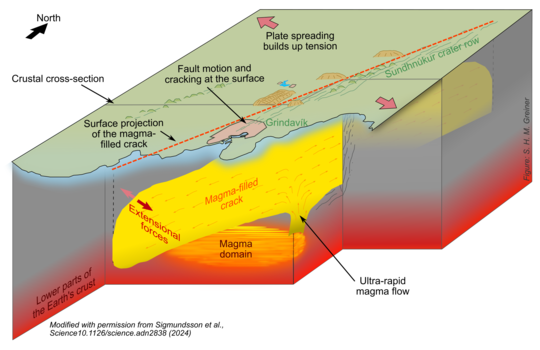New understanding of ultra-rapid formation of magma filled cracks in the Earth
Article in Science led by scientists from University of Iceland and Icelandic Meteorological Office
On 10 November 2023 the town of Grindavík in Iceland was evacuated as massive amounts of magma suddenly flowed into a magma filled crack that propagated underneath the town. Magma was emplaced in a 'vertical sheet' type intrusion in the Earth's crust. An international team of scientists explains the formation of the intrusion, and conditions for ultra-rapid flow into cracks, in a new publication in the prestigious scientific journal Science.
„The great vertical sheet intrusion that formed when the town of Grindavík was initially evacuated on 10 November 2023 is 15 km long and transects the crust from one to five kilometer depth,“ says Freysteinn Sigmundsson, geophysicist at University of Iceland, one of the lead authors of the article
„The intrusion is up to 8 meters wide. At the surface, major fault movements and cracking occurred, causing widespread destruction of infrastructure and property. Most of this activity occurred within a period of about 6 hours.“
“On the evening of the 10 November 2023, initial estimates of magma inflow rate to the dike were extremely high”, says Dr. Michelle Parks, a specialist in volcano deformation studies at the Icelandic Met Office and another of the lead authors. “The estimates were based on modelling of real-time displacement measurements and our initial thoughts were there must be an error in the data. That however was not the case, the input data and modelling results were correct”, says Michelle.
Scientific study based on precise measurements of crustal deformation
The new article in Science is based on detailed observations and interpretation of ground movement patterns, constrained by seismic monitoring.
„The lessons learned are used to explain how extremely long magma filled cracks, more than tens-of-km long, may form through the combined effects of large fractures forming on a boundary of a subsurface magma domain where a very large volume of magma has accumulated, and the effects of extensional forces, that can accumulate in the crust over centuries, for example by the process of plate spreading,“ says Freysteinn Sigmundsson.
According to him such extensional forces can effectively drive magma into cracks.
In the affected area in and near the town of Grindavík, additional, but smaller scale sheet-type magma intrusions occurred in December 2023 and January 2024, but in these cases, the magma intrusions culminated in hazardous fissure eruptions, causing further destruction of the town of Grindavík. Although the magma flow in the eruptions was dramatic, the magma flow on 10 November 2023 when no eruption occurred was much larger. The explanation relates to the extensional forces in the crust, as well as different onset pressure for magma flow to initiate – it took much more to cause the first failure of the magma accumulation area in November, than in the later events in December and January.
Illustration of the Grindavík dike and a proposed magma domain, where magma accumulated prior to the magma intrusion. On 10 November 2023, a dike propagated suddenly under the Sundhnúkur crater row and the town of Grindavík, where fault motion and cracking occurred at the surface. Surface projections of the Grindavík dike and the crustal cross section are outlined by red dashed and grey solid lines on the surface, respectively.





